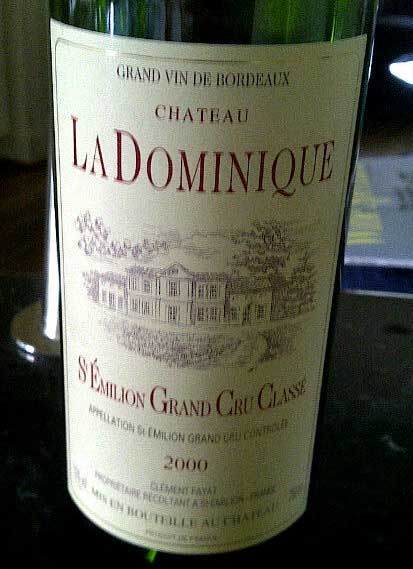The Wine I Drank Last Night: Chateau La Dominique 2000 St. Emillion
It wasn’t a Texas wine. But, it was one of those wines that helps me to better understand what we have (and need to develop more of) here in Texas wine country. I’m not saying that Texas is going to be Merlot country, but some decent Merlot can be made here. Our future is likely tied to different varieties of grapes that like our warm growing conditions and that bud later to miss our far too common late spring freeze.
This weekend, I shot of a quick tweet regarding my recent tasting experience with a notable Merlot.
As I was a reminded in a tweet in response from Ben Calais at Calais Winery (the “French Winery of Texas” based in Dallas) yesterday after I launched a quick tweet about my dinner wine from Chateau La Dominique, “I visited them a while back, next door to Cheval Blanc!”
In fact, Ben was spot on. The vineyard at Chateau at La Dominique is beautifully situated immediately to the east of the famous property of Chateau Cheval Blanc, both on the same sandy glacis, dominated by graves (gravely soil) and siliceous limestone fragments found there. La Dominique is one of the old established vineyards of Bordeaux with records showing that vines were established there as far back as the last half of the 1800s. The name of the chateau comes from a merchant that made his fortune in the West Indies on the island of Dominica.
The record of Chateau La Dominique is long with the reputation that it has made great wines in some vintages, comparable to it’s more famous neighbor. However, with its purchase in 1969, it became a modern winery with expanded use of stainless steel fermentation and new oak barrel. La Dominique is known for it’s Merlot-dominated blend that can also comprise up to 24 percent in roughly equal increments of Cabernet Franc, Cabernet Sauvignon and Malbec depending on the vintage.
I found this wine on the Wine Spectator several years ago in the issue with the title: 90+ rated Bordeaux for less than $40! It was given a WS Score of 91.
I purchased it at Spec’s Smith Street store in Houston and it’s been in my “cellar” [more like a large, 500-bottle wine cooler] with a few of its brethren for the past five years. The WS desciption from 2003 was that it was:
“A rich, beautiful wine. Dark color, with blackberry, smoky and coffee aromas. Full-bodied and very firm, with silky tannins and a caressing finish. Muscular. Best after 2007. 4,580 cases made.”
I can say that it was still all there with dark fruit, maybe with a bit of red plum, and then something else, too.
The wine had become more earthy with the aged scent of “forest floor”: a really great descriptor that I’ve found that describes an aromatic quality that combines aromas of wet earth or mushroom caused by high levels of geosmin that occur naturally in grapes.
After the use of this descriptor in my tweet, I got a response from @Purplejules that asked the question: “@VintageTexas What does a forest floor taste like? Moss? Dirt? Animal droppings? Not sure I’d Like that.”
This may fall into the category of “too much detail”, but geosmin, which literally translates to “earth smell”, is an organic compound with a distinct earthy flavour and aroma, and is responsible for the earthy taste of beets and a contributor to the strong scent that occurs in the air when rain falls after a dry spell of weather.
To read about my previous encounter with this sensation in the Texas Hill Country, click here before I knew that the single term that described it.
The human nose is extremely sensitive to geosmin and is able to detect it at concentrations as low as 5 parts per trillion.
Well, back from my deep dive on forest floor aromas and geosmin.
In some parts of the world, Merlot can achieve a degree of recognition and perfection like in this Merlot blend from St. Emillion. As I’ve already admitted, it is most likely not in Texas.
The La Dominique was still an exceptionally good bottle of wine and another check on the Internet for recent auction house price of this wine said that it was in the range of $60 of a bit more.
The food accompaniment for this bottle of wine was on the opposite end of the geographic spectrum: local beef, a grass feed Texas rib eye steak, served with a sauté of mushrooms, onions and tomatoes.
Enjoy.


Be the first to comment